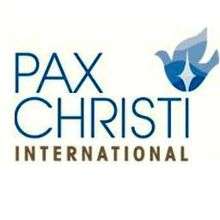Pax Christi
Pax Christi International is an international Catholic peace movement. The Pax Christi International website claims its mission is "to transform a world shaken by violence, terrorism, deepening inequalities, and global insecurity."[1]

History
Pax Christi (Latin for Peace of Christ) was established in France in 1945 through the inspiration of Marthe Dortel-Claudot and Bishop Pierre-Marie Théas. Both were French citizens interested in reconciliation between French and German citizens in the aftermath of World War II.[2] Some of the first actions of Pax Christi were the organisation of peace pilgrimages and other actions fostering reconciliation between France and Germany. Although Pax Christi initially began as a movement for French-German reconciliation, it expanded its focus and spread to other European countries in the 1950s. It grew as “a crusade of prayer for peace among all nations.”[3]
Pax Christi was recognized as “the official international Catholic peace movement” by Pope Pius XII in 1952.[4]
It also had chapters in the United States. In the 1960s, it became involved in Mississippi in organizing economic boycotts of businesses that discriminated against blacks, in an effort to support protesters in the civil rights movement, who were trying to end discrimination in facilities and employment. It was active in Greenwood, Mississippi, among other places.
In 1983, Pax Christi International was awarded the UNESCO Peace Education Prize.[5]
The Pax Christi network membership is made up of 18 national sections and 115 Member Organizations working in over 50 countries.
Peace work
Pax Christi focuses on five main issues: human rights, human security, disarmament and demilitarisation, just world order, and religion and peace.[6]
Organization
Pax Christi is made up of national sections of the movement, affiliated organizations and partner organizations. Its International Secretariat is in Brussels. Pax Christi has consultative status as a non-governmental organization at the United Nations.[7]
International Presidents of Pax Christi
- Maurice Feltin (1950–1965)
- Bernard Alfrink (1965–1978)
- Luigi Bettazzi (1978–1985)
- Franz König (1985–1990)
- Godfried Danneels (1990–1999)
- Michel Sabbah (1999–2007)
In 2007, a co-presidency was created, a bishop and a lay woman.[8]
- Laurent Monsengwo (2007–2010)
- Marie Dennis (2007 – present)
- Kevin Dowling (C.SS.R.) (2010 – present)
See also
References
- ↑ "Why Pax Christi - Pax Christi". www.paxchristi.net.
- ↑ "History - Pax Christi". paxchristi.net.
- ↑ Pogorelc, Anthony J., Encyclopedia of American Religion and Politics, 2003, Pg. 317
- ↑ Dennis, Marie, “Pax Christi International” Archived 2014-03-04 at the Wayback Machine., CMSM Forum, Summer 2008
- ↑ "Unesco Prize for Peace Education". Unesco. 9 March 1983 – via Google Books.
- ↑ "Our Work - Pax Christi". www.paxchristi.net.
- ↑ "Our History". 1 January 2011.
- ↑ "History - Pax Christi". www.paxchristi.net.
Further reading
- Roger S. Powers; et al., eds. (1997). "Pax Christi International". Protest, Power, and Change: An Encyclopedia of Nonviolent Action. Routledge. ISBN 978-1-136-76482-0.